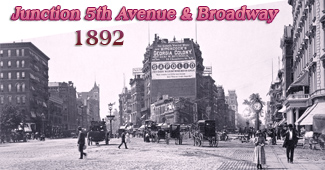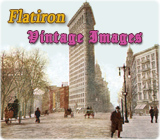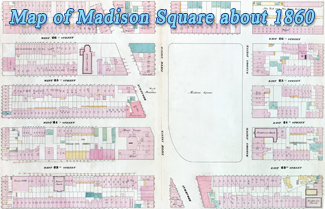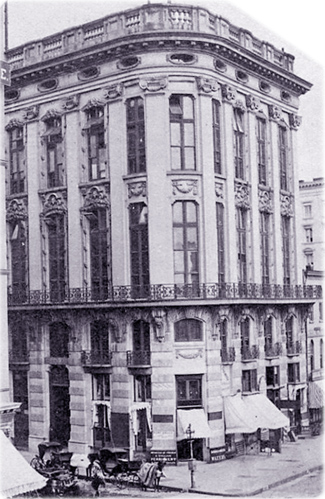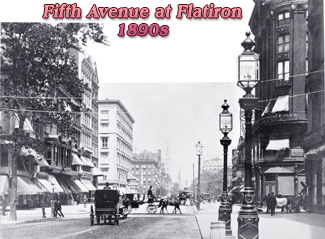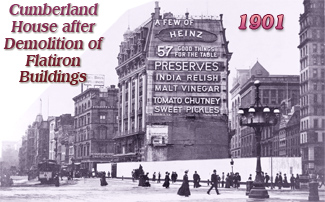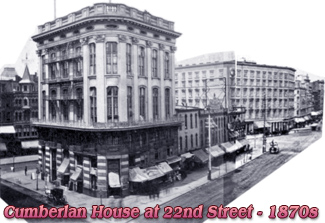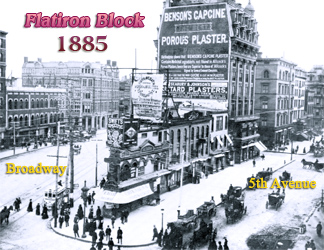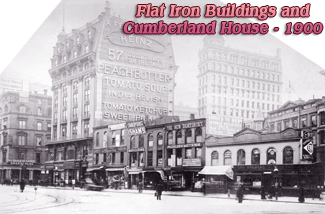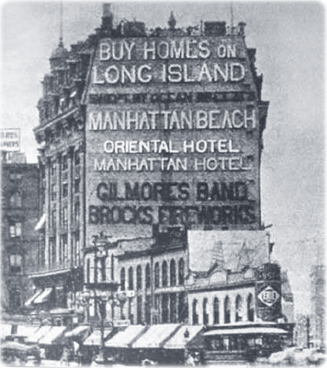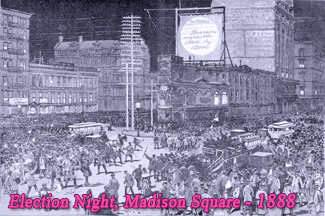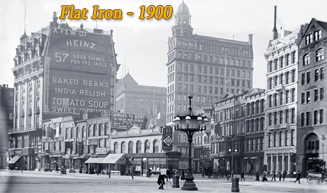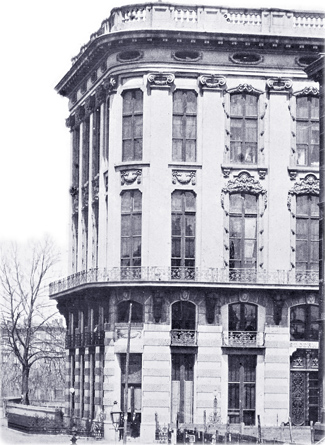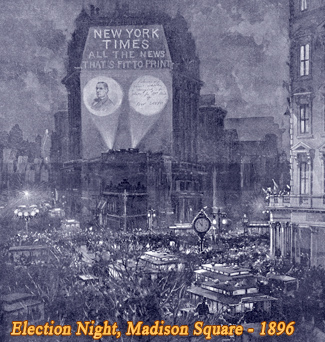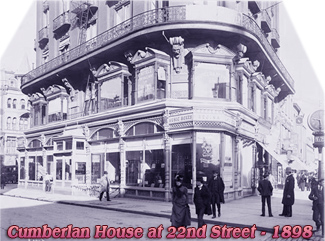The Hotel St. Germain stood at the junction of Broadway and
Fifth Avenue, at 22nd Street (175 Fifth Avenue / 1 and 3 East 22nd Street), now part of the site of the landmarked Flatiron Building,
completed in 1902. The old hotel opened in February 1856. In 1880, it was
renovated, expanded and renamed Cumberland House. It was demolished in 1901.
In 1850, the triangular block, formed by Broadway, 5th Avenue, 22nd and 23rd streets, was acquired by Amos R. Eno (1810-1898), a real estate investor and capitalist.
On January 23, 1856, an advertisement in the New-York Daily Tribune read: «Hotel St. Germain, 22d-at., 5th-av., and Broadway. −Francis Rider respectfully informs his friends and the public that he has leased the above Hotel, and will be ready for the reception of Visitors in a few days.»
On the same day, the New York Times reported: «The unique building in Fifth-avenue, near Twenty-third street, which has excited the attention of the public in the past year, is to be opened as a hotel with the most aristocratic name in the Saints' calendar, viz.: St. Germain. We have now a St. Denis, St. George, St. Nicholas and St. James, and a good many hotels that might be called St. Giles. Mt Ryder, formerly of the West Point Hotel, is the host of St. Germain». On April 22, the newspaper reported: «No one can fail to observe the change for the better in the architecture of New-York within a few years. ...If the houses in New-York were in light colors, like those of the more beautiful cities of Europe, the improvement in the beauty of the whole City would be astonishing − so light and cheerful. Compare the Everett Hotel, the Clarendon, the Brevoort, the Howard, the St. Germain, and others...», but on June 9, the same newspaper noted: «The Broadway front of the St. Germain Hotel is cracking badly. It is built of French Gaen stone.»
The Hotel St. Germain opened on the evening of February 7, 1856, for the reception of invited guests, by Francis Rider, former proprietor of the West Point Hotel.
The Hotel St. Germain was built of Caen stone and it had an imposing external appearance. A cast-iron balcony surrounded the third floor. The interior was beautiful and well decorated. The suits of apartments opened upon a common center or a large rotunda, reaching to the roof. Each parlor upon the main floor had a sleeping apartment connected with it, immediately above, reached by an enclosed staircase. The St. Germain had garden on the northern part of the site, but, about the early 1860s, office buildings with stores were erected on this part.
On April 6, 1856, the New York Herald reported: «The up-town public are grateful for the private enterprise shown by the recent establishment of two new Post offices, one situated on Broadway, in the new and elegant St. Germain Hotel, under the title of Madison square Post office; another, called the Central Post office, located at the junction of the Sixth avenue and Broadway, ...»
On May 07, 1856, the hotel advertised in the New York Herald «Stores on Broadway to let − under the St. Germain Hotel... They are well adapted for gentlemen's furnishing, thread and needle, or any other fancy business, having entrances into the hotel.» On May 19, 1856, the New York Herald reported (from Sunday Times): «We perceive that Phelan's model billiard tables and combination cushions are coming greatly into vogue. The Everett House has them, so the Hotel St. Germain, ...»
In the following years several other hotels and apartment houses opened around Madison Square: St. James in 1857, Worth House about 1858, Fifth Avenue Hotel in 1859 (built by Amos R. Eno), Albemarle in 1860 and Hoffman House in 1864 were some of them.
By March 1869, the Hotel St. Germain changed hands. It was renovated and reopened as a "first-class French boarding house, for the accommodation of respectable families and single gentlemen. ... Spanish, German and English spoken", according to an advertising in the New York Times in the Boarding and Lodging section.
External fire escape was installed on the 22nd Street side of the hotel after an inspection of the Department of Buildings in January, 1873. On February 10, 1877, a fire made some damage to the building. About the 1870s, the hotel's façades were stripped of some of their external decoration. In the late 1879, the hotel began a renovation an expansion and a two-story mansard roof was constructed. The seven-story hotel reopened about the mid-1880. About that time, the hotel changed its name to Cumberland (apartment house).
In December 1880, the brokerage firm C. I. Hudson & Co., had a branch office at the Cumberland.
In 1885, Austin Corbin (1827-1896), president of the Long Island Railroad Company, leased the rear wall of the Cumberland, facing Madison Square, for advertising (it was used for that purpose since at least the 1860s). Corbin also bought the Long Beach Hotel, the same year. He, with the help of the Edison Illuminating Company, perfected the electric light advertising on block letters and this system appeared for the first time in New York City, on June 10, 1892, built in this same wall (photo on the right). It was 80 feet tall and 60 feet wide and held 1,457 bulbs of different colors, with letters varying from three to six feet in length. It had a hand-operated flashing mechanism, operated from dusk until 11 o'clock each night. It read "Buy Homes on Long Island, Swept by Ocean Breezes" and also advertised for Corbin's Manhattan Hotel and Oriental Hotel and two theatres: Gilmore's Band and Brock's Fireworks. In 1896, the New York Times rented the wall, for the winter season, to place its own colored-light signs, calling it «the best "AD" in the City». The different lines were of different colors and were illuminated in succession. Later, the newspaper announced the result of the presidential election, won by William McKinley, using its illuminated advertising. Later, the wall was taken over by the H.J. Heinz Company, which hired O.J. Gude, an outdoor advertising pioneer, to place its immense electric pickle sign.
In 1890, the executive committee of one of the faction of the Republicans opened at the Cumberland.
The Jockey Club, founded on February 9, 1894, had its offices in the Cumberland until 1901. Their meetings in the place began before its foundation. On January 31, for example, the New York Times (February 1, 1894) reported: «The joint committee of horse owners and the Board of Control had a meeting yesterday afternoon in the Board of Control rooms, in the Cumberland, Twenty-second Street and Fifth Avenue. ...The meeting was called to consider the reply received from the Coney Island Jockey Club».
By 1896, E. A. Cruikshank & Co. was the manager. About the early 1901, the Cumberland, owned by Hickson W. Field estate, was acquired by parties interested to erect the Flatiron Building. They formed the Cumberland Realty Company, an investment partnership created by Harry S. Black, CEO of the Fuller Company. The Cumberland House was demolished between May and June, 1901. More: Flatiron block before Flatiron Building ►
